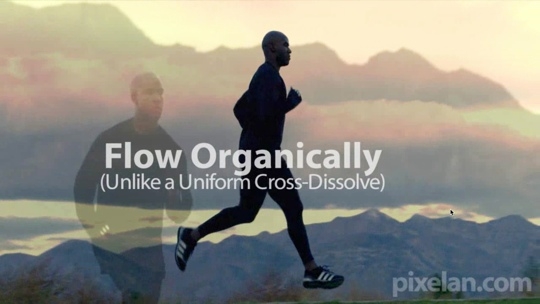
 Dissolve Mater
Dissolve Mater
Pixelan plugins have been on the digital video editing scene for about as long as there has been a digital video editing scene. We talk to founder Michael Feerer about their past, present and exciting future
RS: When Pixelan started, what was digital video like back then?
MF: Those were thumbnail days, when big digital video output meant 160x120 pixels. Even at that size, movies often played choppy because most desktop computers didn’t have enough horsepower. Hard disks then were relatively slow. And video codecs were not as advanced as they are now.
RS: Lots of users from the YouTube generation don’t know about those thumbnail times.
MF: That’s right. Now streaming full-HD video is no big deal. I still find it amazing. I feel like a graybeard for saying that, but I like having been through that history first-hand. I have a lot of appreciation for what we can creatively do now.
RS: What led you to developing video effects plugins in the first place?
MF: I had written the book Premiere with a Passion which was published by Peachpit Press. That was one of the first books for digital video. It was about how to creatively use Adobe Premiere, which was about all there was back then to edit with. Almost as an afterthought, I included a floppy disk -- remember those? -- that held a few dozen transitions and effects that could be added to Premiere.
RS: What got you from that first floppy disk to Pixelan?
MF: Premiere with a Passion was popular. I received a bunch of fan mail. Real, physical mail in those pre-Internet days. A big pile grew about the book, and another big pile grew from users begging me to create more effects. After the book went into second edition and raising my toddler daughter became less time-demanding, I decided to get serious about the second pile. I spent several months creating a CD of more effects and transitions. That CD was called Video SpiceRack and quickly became popular worldwide.
Coincidentally, later that year the Spice Girls started to make a big splash internationally. They have nothing to do with us. But the spice metaphor was very much in people’s minds then.
RS: So Video SpiceRack is what you started Pixelan with?
MF: Yes, it will be 18 years ago this January. For effects plug-ins, there was basically just BorisFX and Pixelan spices.
RS: Why were your video effects and transitions in such demand?
MF: Well, I wasn’t a software engineer. I was a successful architect and a life-long creative designer, so I conceived them like an artist or designer would. I prefer soft-edged and organic. Those qualities are timeless to me and are inspired from the natural world. It’s not a fad, geeky, or “in your face”. It’s not violent like explosions or other Star Wars-inspired effects. Or silly looking like analog video switchers. I didn’t care soft and organic was not common in the video world. Heck, I did not even own a TV, intentionally, so maybe I had fresh eyes, a beginner’s mind. That helped. My intuition as a life-long designer guided me. It still does to this day.
Keep in mind, the beginning of the desktop video revolution was a lot like the beginning of the desktop publishing revolution, when you would see documents with 13 different fonts in them -- just because people could. So it took a while for soft, subtle, and organic qualities to be noticed and ultimately preferred. I think we helped that movement along a little bit. It was contrary to throwing all sorts of digital eye candy into a video.
RS: What came after Video SpiceRack?
MF: I created a followup CD a year later called OrganicFX. Then I started working with a very talented software engineer -- Ivan Ivanov -- who had contacted me because he was also very interested in these kind of effects. I realized he could leverage their power even further. That’s what led to SpiceMaster. He was Pixelan’s first employee and we continue to work closely together to this day.
RS: How was SpiceMaster different from Video SpiceRack?
MF: Video SpiceRack was only adjustable for edge softness. You’d pick a transition geometry and then tweak the edge softness as desired. That’s all. SpiceMaster, in contrast, gave users the power to adjust virtually everything in the transition -- geometry, placement, movement, timing, various edge enhancements, etc. -- and keyframe those qualities over time. Also, with our Mixer slider for the first time someone could variably alter the transition’s shape to what was actually in the scene, so the results became a lot more seamless and natural looking. Plus we added soft-edged, organic picture-in-picture effects and title effects. Tens of thousands of editors have used SpiceMaster over the years.
RS: My understanding is SpiceMaster also can animate other video effects. True?
MF: Yes, in fact that is its most overlooked feature. Typically when you apply a video effect, by default it alters the entire scene. Sure, some moving masks or simple garbage mattes can limit the effect area, but there really isn’t a lot of control in most video editing systems to dynamically flow or animate a video effect over time within a single scene. SpiceMaster solves that easily.
RS: Give me an example.
MF: Imagine a clip with your subject in a sailboat and you are slowing zooming out during a sunset, but you want to further warm that sunset’s glow during the clip’s in a way that radiates subtly outward from the subject to the frame edge. You don’t want some sort of simple oval or other hard-edged mask geometry to distract the viewer and basically look amateurish. Instead you want to gently and unobtrusively lead the audiences eye. You want everything to appear natural and respond visually to what’s in your scene. SpiceMaster can do that in a snap. Soft, flowing, and subtle.
RS: Subtle. I don’t tend to associate that with video effects I often see.
MF: To us, subtle is a key concept. Every one of our plug-ins does subtle looks in some way. That’s usually their main emphasis. Sure, because of their adjustability anyone can crank up our controls and create cutting-edge extreme looks too. That’s okay, as long as we give users a true choice to go either way.
Our effects and transitions have been used in everything from home videos and thousands of YouTube movies to indie films and big Hollywood productions. The effects we contribute are usually so subtle the audience doesn’t realize it happened. Only the editors know. That’s actually the best way, when the effect or transition enhances and the viewer has no clue one was used.
RS: SpiceMaster can flow any effect?
MF: Yes. It can softly or organically flow any of the built-in or third-party effects plugins in a user’s editing system. That leverages the visual power of a user’s entire collection of video effects. It gives people lots more creative control over all of them, without having to say detour into After Effects and climb an immense learning curve there.

RS: What came out from Pixelan after SpiceMaster?
MF: We released 3D Six-Pack as an alternative approach towards 3D particle transitions and page turns/rolls. Ours are beautifully flowing with wind, gravity and other environmental influences affecting how they disperse or come together. We also developed CreativEase, a suite of affordable video effects plug-ins that plugged some of the gaps in the effects capabilities of Premiere, Vegas, etc. Organic blurs and time-based motion effects, to name a few.
Then we spent about two years quietly in the background not introducing anything new. What we were doing was developing a hardware-accelerated plug-in architecture. With that near-real-time code foundation, and an all-new cool custom interface since most users now have hi-res screens, over the past 18 months we released DissolveMaster and FilmTouch 2.
RS: How is DissolveMaster unique?
MF: We aimed high -- to create the ultimate tool for dissolves and fades of all types, including some that were not previously possible. In most editing programs, dissolves and fades do not offer any adjustability or customization to achieve exactly the look you desire that best relates to your content. DissolveMaster changes that. It’s a great enhancement even for pure "cuts and dissolves" editors.
A simple cross dissolve is the most used video transition other than a cut. It’s simple, clean, and unobtrusive. Terrific. Drag and drop, and move on. That’s fine for some projects, but what if you are working on a digital film or other video where it might be advantageous to subtly start -- or end -- the dissolve in a particular place within the scene? Or tweak the dissolve’s uniformity slightly to relate to what’s occurring, such as emphasizing a subject’s motion or location? Or what if you want to add a subtle glow or blur momentarily to the dissolve’s expression? These are but a few examples of what DissolveMaster makes easy with a few clicks.
RS: Where can we see examples of this?
MF: We have a 2-minute DissolveMaster overview movie at the Pixelan YouTube channel. Several other movies are at our DissolveMaster main page. DissolveMaster includes more than 500 presets, and you can save your own easily, so you don’t have to re-invent the wheel each time you apply it.
RS: Tell me more about your film looks plugin -- FilmTouch. Isn’t that a me-too product, since there are lots of other film looks plug-ins by your competitors?
MF: Well, what our plug-in competitors have done well, in my opinion, is approximate a lot of historical and classic film looks. That can be handy for some projects, but in our discussions with video editors, what they more commonly want are attractive treatments to enhance their footage. In many cases, it doesn’t matter to them if the film look has a particular Fujifilm or Kodachrome feel, or whatever. They just want the treatment to make their output look great.
So we let go of doing a “me too” film looks plugin and instead loaded ourselves up with all sorts of real-world test clips that were white-balanced a little off, too dark or bright, etc. -- the kind of footage situations video editors face everyday, whether from their own camcorder or from stock. We also made sure that every one of those clips included people, because skin tones in some well-known plug-ins -- I won’t name names -- some of their presets actually end up giving skin weird green casts, skies unreal blue tones, etc. Those are visual cues people relate to in the real world. Some of their presets plug up shadow areas or blow out highlights. That’s not acceptable to us. We looked very carefully at those issues in designing FilmTouch Pro, making sure that its 500+ presets didn’t create such problems. We then wrapped that in a highly adjustable, hardware-accelerated architecture so users would not have to wait to get great results. And they could tweak as much as they wanted to tailor the presets to their exact needs.
RS: Nowadays there are a lot of effects plug-in providers. What distinguishes Pixelan from the rest of the pack?
MF: Well, we price our plugins very affordably, but try to make them deep. We pack in a lot of flexibility and power through custom interfaces and lots of adjustable controls. We’d rather our users have a few deep plugins from us than dozens of single purpose “pluginettes” as we call them, which we see lots of users having a hard time even remembering they have.
We also really focus on customer service. We get a lot of joy doing that, believe it or not. Good service is so hard to find in the software world these days. We are intentionally a small company, even though we have been very popular over the years. We aim to respond to user inquiries within a few hours instead of a few days. Even quite often on weekends and holidays, because we know users can be left hanging trying to complete a project then and need answers quickly. We want to provide service like we ourselves would like to get. We don’t farm any of it out. You get long-time Pixelan employees -- often me -- responding on a daily basis. Even though I founded Pixelan and am its head honcho, I still like to do customer service, to keep my pulse on what users are experiencing. Lots of testimonials about our service are at our website.

RS: You’ve mentioned plugins for Premiere, Vegas, etc. but what about Lightworks? We have a lot of Lightworks users on our site.
MF: We like what we see in the Lightworks environment. Hopefully over time their plugin architecture will support having us on board. Since our plugins are affordable and do a lot of things Lightworks currently cannot, it would be a good fit. Time will tell.
RS: And what about Mac users?
MF: We actually started out as Mac developers. Those early spices were only on the Mac. But in later years an arrogant Apple wasn’t much interested in supporting plugin developers. So we left the Mac and license some of our Mac effects to other Mac developers, such as GeeThree. Times have changed though and we intend to come back to the Mac in a big way in 2014.
RS: In closing, I am wondering what lights your inner fire these days. What other passions do you have?
MF: Well, I love fine art nature photography and am an avid hiker. I try to get into the wilds for at least an hour every day, often to photograph. Sales at my photography website create donations for the animal world. I am also working on my first children’s fiction book, a middle-grade novel that takes place in the desert, another environment I love. All of this is mixed in daily with guiding Pixelan, designing new plugins, and answering user questions.
RS: So does Pixelan have more cool stuff cooking in its kitchen?
MF: You bet. 2013 was a very active year for us. We released FilmTouch 2 and added CyberLink PowerDirector, Magix Movie Edit Pro and Video Pro versions to our entire plug-in product line. We hope 2014 will even top that. Stay tuned!
Tags: Business


Comments